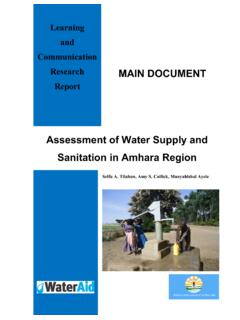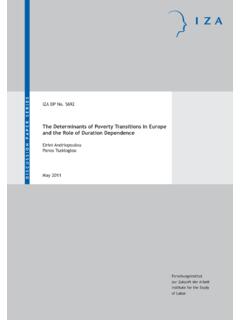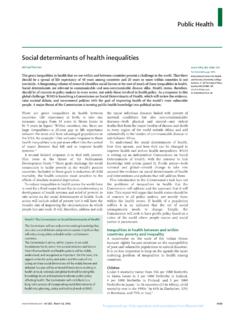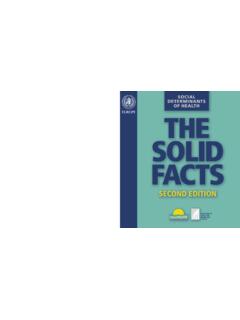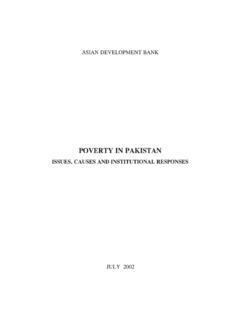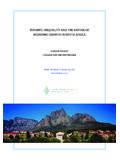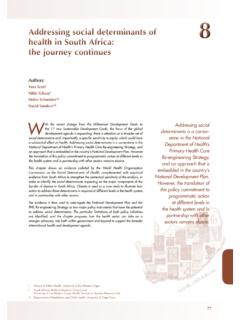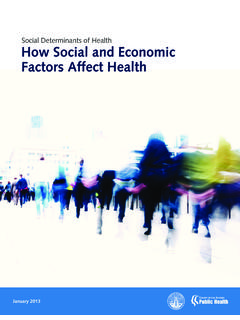Transcription of ASSESSMENT OF DRINKING WATER QUALITY AND …
1 ASSESSMENT OF DRINKING WATER QUALITY AND DETERMINANTS OF HOUSEHOLD POTABLE WATER CONSUMPTION IN SIMADA DISTRICT, ETHIOPIA A Project Paper Presented to the Faculty of the Graduate School of Cornell University in Partial Fulfillment of the Requirement for the Degree of Master of Professional Studies (MPS) By Meseret Belachew Addisie January 2012 2012 Meseret Belachew ABSTRACT The current aim of the Ethiopia s Millennium Development Goal declaration is to alleviate poverty through improving the strategy of effective utilization of WATER supply sources.
2 In order to achieve the goal, a priority area is providing adequate and QUALITY WATER . The study was conducted in Simada District, Amhara Regional State, Ethiopia, where after considerable expansion of the WATER supply systems, people still rely on unimproved WATER sources that may be contaminated with waterborne diseases. The objective of the research was to investigate the reasons behind the use of unprotected sources in both urban and rural settings. Sixteen WATER points were selected. Three WATER points (that were functional) were located in urban areas, and the remaining 13 in rural areas ranged from nonoperational to completely functional.
3 Forty four households were interviewed in the urban area and 116 in the rural area, covering WATER consumption behavior, perception of WATER source QUALITY , and factors determining use. WATER QUALITY was determined at 11 selected WATER points representing both improved and unimproved sources. In the urban areas people were generally satisfied with the WATER services provided by the municipality because the WATER QUALITY was good and walking distances were short. The WATER cost was considered high especially for the poor who could not afford the cost and therefore used alternative unprotected services.
4 In response, the municipality recently lowered the cost.. In other cases, because most of the systems were only a few years old, some people were not adjusted to taste and went back to the original, lower QUALITY WATER sources. On some days, waiting times were too long, forcing some people to use a more distant, unimproved source. In contrast, more people in the rural areas did not use the constructed WATER points because of the QUALITY of WATER , adequacy, distance and longer waiting times. Systems had broken down or failed for several reasons, the main one being that a functional organization did not exist within the community to manage the WATER supply.
5 Other people who were dissatisfied did not like the taste of the WATER , could not pay for the WATER services and therefore sought out alternative unimproved sources. Sanitation coverage in urban areas was much less than that in rural areas where more extension and promotion has been conducted. Construction of latrines without waste decomposition or removal mechanisms service and the habit of open defecation were common problems especially in urban peripheries. iii BIOGRAPHICAL SKETCH Meseret Belachew Addisie was born in South Gondar zone Ethiopia on 30 November 1985.
6 He received his Bachelor of Science Degree from Mekelle University under the department of Land Resource Management and Environmental Protection (LaRMEP) in 2006. Before he attended the MPS program offered by Cornell University at Bahir Dar University Ethiopia in 2010, he worked as soil and WATER conservation expert for one and a half years, and two years as food security program (productive safety net program) coordinator in Simada district Office of agriculture and rural development. He is interested to continue his understanding on environmental issues and WATER resource development programs.
7 On behalf of God. iv ACKNOWLEDGEMENT My special and uppermost acknowledgment is extended to my Professor Tammo S. Steenhuis who brought the MPS program in to Ethiopia and gave me the chance to learn. In addition he shared his valuable guidance and precious advice during all the months of my work and provided funding. I also wish to express my special gratitude for Dr. Amy S. Collick for her valuable input on all issues of concern at any time and place. Besides that, her contribution from the start of the program to advising the draft of my research contributed to its final success.
8 Their enthusiasm and that of all the members of Cornell University s instructional team who taught and advised me in all circumstances regarding their subject matter helped my proposal and motivated me to follow this exciting research experience. I am also indebted to PhD students at Cornell University Seifu Admassu, Essayas Kaba and Kim Falbo. My sincere gratitude goes to the District rural WATER supply and sanitation experts: Abay Mesele, Mekuanint Bitew, Fasil Asafie and their staff experts, as well as to the FHE project WATER experts, especially Gebrie Telak and all drivers who supported me during my stay.
9 I would also like to thank my friends Negash Alebachew and Muluye Alemnew who provided great cooperation and companionship during data collection. I am also grateful to Yimam Berihun, Gizachew Desalegn and Genet Wubie for their enormous contribution with available materials. Great thanks go to Birtukan Misganew and Wubedil Ayalew who helped me during WATER sample collection. I am gratifying Alebachew Nibret for his motivation and strengthening me for the success of my goings-on beside my stay as an employee. Finally, my special thanks to all my classmates especially Getaneh Kebede and Habtamu Addis for their warm friendship and a lovely memorable time in Bahir Dar.
10 Thanks to my God . v TABLE OF CONTENTS BIOGRAPHICAL SKETCH .. iii ACKNOWLEDGEMENT .. iv TABLE OF CONTENTS .. v LIST OF FIGURES .. vii LIST OF TABLES .. viii ABBREVIATIONS .. ix 1. INTRODUCTION .. 1 Background .. 1 Justification .. 4 Problem .. 4 Goals and Objectives .. 5 2 LITERATURE REVIEW .. 7 The Need for WATER Supply and Sanitation .. 7 WATER QUALITY parameters .. 10 Perception of DRINKING WATER .. 10 Bacteriological parameters .. 11 Chemical parameters .. 13 Physical and aesthetic parameters .. 14 3 MATERIALS AND METHODS.


